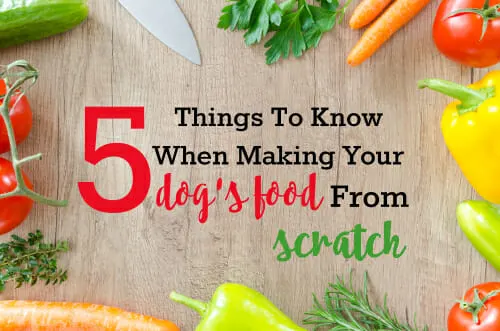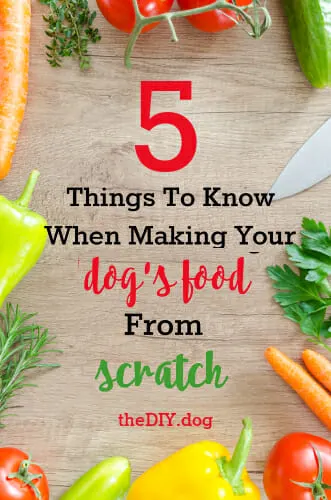As a member of the Etsy affiliate program and an Amazon Associate, I earn from qualifying purchases.
So, you are considering switching your dog from store-bought dog food to a homemade diet?
If you are a novice at making dog food from scratch, it may seem like there is an overwhelming amount of information to learn. However, you can start off with some basic nutritional guidelines for dogs and continue to learn as you go.
The advantages of homemade dog food are well worth the effort. The following tips on feeding, variety, supplements, and foods to avoid will arm you with some basics.
Keep in mind that with a little research, your beloved, four-legged family member will be reaping the health benefits of healthy, home-cooked meals.

Herbs with knife on wood table
Editor’s Note: When we adopted our Felix, he was a hot mess. Allergic to everything, itchy all the time, and a walking hot spot. After a couple years of trying to make it better, we had settled on giving him heavy doses of steroids and allergy meds to make him comfortable. I hated it, but I didn’t know what else to do. A chance encounter at an event introduced us to Dr. Peter Dobias. This meeting and Dr. Dobias’ advice dynamically changed what I feed my dogs, how I approach canine health and so many aspects of our day to day life. I’m so excited to welcome him to the blog today to share his tips on making your own dog food. It is our belief that a nutritionally incomplete homemade diet can be extremely dangerous and we encourage you to do your research and talk to your vet prior to changing your dog’s diet. – Jodi
This post links to several products on the Dr. Dobias’ own website. We have been using several of these products ourselves for a number of years and believe they are a great fit for our dogs. That said, always speak to your vet prior to adding products to your dog’s diet.
Advantages of Homemade Dog Food
There are many advantages to making dog food from scratch. Perhaps, the most obvious is that you know exactly what your dog is eating because you purchase the ingredients. No more trying to read labels with hard to pronounce ingredients. You can buy fresh fruits, vegetables, meats, and grains locally, from a farmer’s market, grocer, or butcher. The result is a nutritionally dense, fresh meal.
Homemade dog food has another advantage over storebought dog food; it is prepared in smaller amounts and meant for faster consumption (since the only way to safely store homemade dog food is in the freezer). Therefore the foods you make are free of preservatives, which are often added to commercial dog food to increase shelf life.
Since commercial dog food is cooked in large quantities, it is cooked at extremely high temperatures and in large amounts of water. Unfortunately, high temperature and the addition of water cause the food to lose a lot of its nutrients.
Further, commercial dog foods will use ingredients like meat meal rather than meat, and animal by-products such as hooves, feathers, and brains. Food cooked from scratch is cooked at lower temperatures, in smaller amounts, with less water, and without any hidden ingredients, thus retaining its nutritional value.
Variety is the spice of life – even for your dog.
If your dog lingers by your feet while you eat dinner hoping to catch a falling table scrap, it could be that he longs for the variety of foods at your dinner table. Even if you are feeding him a kibble diet that meets his nutritional needs, it likely gets mundane. Would you feed your family the same meal daily? Probably not.
Just as variety is the spice of life, variety is the key to a healthy homemade diet. So read up on different home-cooked meals. Try out new homemade recipes and make sure to feed your dog a wide variety of foods from all the different food groups.

.Feeding Complete and Balanced Homemade Dog Food is Key.
You need to make sure your dog’s diet is complete and balanced. This means his diet meets all of his nutritional needs. There are veterinary nutritionists who can help develop the perfect homemade diet for your pet.
Complete and balanced does not mean that every meal must meet all of your dog’s nutritional needs, but rather his overall diet must meet all of his nutritional needs.
The best way to ensure a nutritious homemade diet is to include meat, poultry, fish, eggs, some dairy, vegetables, fruits, and grains. No one type of food should make up more than half the diet.
Guidelines for feeding home cooked dog food
The following are general balance guidelines for necessary nutrients:
- 40% Protein – animal meat, seafood, eggs or dairy
- 10% Carbohydrates – grains and beans
- 50% Vegetables
- Fat – from oil or meat
- Calcium – crushed or powdered eggshells; a supplement
- Fatty acids – cooked egg yolks, oatmeal, plant oils and other foods
The amount of food is always based on your dog’s size and activity level.
If your dog is overweight or has health issues, make sure to consult your veterinarian before changing his diet. Your vet will be able to assist you with the healthiest homemade diet options for your dog.
Regardless of the diet you choose, it is important to follow homemade dog food recipes exactly to ensure your dog is getting his nutritional needs met.

Foods to Include in a Homemade Pet Food
- Meat/Animal Products – Should make up approximately half of the total diet.
- Raw Meaty Bones – Some people choose to feed Raw Meaty Bones (RMBs) – edible bones covered in muscle meat – as part of a home cooked diet. They are a good source of calcium and the bone marrow provides nutritional benefits. This is a personal preference. However, one thing you must know is never feed cooked bones.
- Eggs – A nutritious addition to any homemade diet.
- Dairy – Mammals are not naturally meant to consume milk in adulthood. That goes for dogs too. There are plenty of other good calcium sources that do not run the risk of causing allergic or digestive issues, like GreenMin Mineral Superfood, which is high in natural plant-based calcium.
- Vegetables – An excellent source of fiber and antioxidants which support digestion and immunity.
- Starchy Vegetables – such as sweet potatoes, squash, beans, and pumpkin have to be cooked in order to be digestible. These provide carbohydrates for active dogs. Limit portions of starchy vegetables if your dog is overweight.
- Leafy Greens/Non-Starchy Vegetables – are low in calories. However, too many may result in gas. Raw vegetables should be pureed in a blender or food processor in order to be digestible by dogs.
- Fruits – Apples, bananas, berries, and melons are always great choices to add to your dog’s diet. They are good for meals and treats. Steer clear of grapes and raisins, both of which are toxic to dogs and can lead to kidney failure.
- Grains – Some very nutritious grain choices are oatmeal, brown rice, quinoa, and barley. Grains that contain gluten may cause digestive problems for some dogs.
Supplements
You will have to add supplements to your dog’s diet to ensure he is getting all nutrients.
Everyone who feeds a homemade diet is advised to supplement with calcium (unless raw meaty bones are part of the diet). Eggshells are a great source of calcium and are easily ground into a powder.
It is also a good idea to include a complete multivitamin.
(Editor’s note: Both Kol and Fe get SoulFood as a part of their regular diet.)

This happy boy had his life changed because of a chance encounter with Dr. Dobias and a diet filled with fresh foods.
Oils
Omega-3 oil – such as salmon oil, EPA oil, or squid oil is one of the best additions you can make to your dog’s diet. It provides essential omega-3 fatty acids, which are known for benefits such as:
- Maintaining a healthy coat and skin
- Regulating the immune system
- Lowering blood pressure
- Reducing inflammation
Cod liver oil – is high in vitamins A and D. You might consider adding this to your dog’s diet if you do not regularly include fish in your recipes.
Plant oils – are a good source of linoleic acid, an essential omega-6 fatty acid. Linoleic acid may be in short supply if you do not regularly include dark poultry meat and skin in your meals. Good sources of linoleic acid are walnut, corn, vegetable, and hempseed oils.
Making dog food from scratch should be fun for you and your dog.
You can start making the switch while you continue to read up on homemade diets.
Remember it is a process. You can, and should, constantly reevaluate your dog’s health and diet, and make changes when appropriate. Get creative. The following list of foods your dog should not eat is meant to keep everyone out of harm’s way.

Foods Your Dog Should Never Eat:
- Alcohol
- Chocolate – can be toxic to dogs.
- Cooked bones
- Corn on the Cob – can block dog’s intestines.
- Fat trimmings – can cause pancreatitis.
- Xylitol – an artificial sweetener found in sugar-free gum and candy is poisonous to dogs. Xylitol is also added to a few peanut butter as a means of cutting calories.
- Tobacco – is a major toxic hazard for dogs.
- Coffee – contains caffeine which is poisonous to dogs.
- Macadamia Nuts – contain a toxin that can ultimately damage your dog’s digestive, nervous, and muscle systems.
- Onions and Chives – contain disulfides and sulfoxides which can cause anemia and damage red blood cells.
- Peach and plum pits – can cause intestinal obstruction.
- Hops – an ingredient in beer that can be toxic to your dog.
- Pear seeds – contain a trace amount of arsenic.
- Candy and Chewing Gum
- Avocado
- Yeast (alone or in a dough) – Yeast is meant to rise in bread. It is not meant to rise in your dog’s stomach and if it does, it can be quite harmful.
If you are new to making dog food from scratch, this may sound like a lot to digest.
If you feel like you are in over your muzzle and questioning whether or not you should stick with your comfortable kibble diet, remember that this will be a learning process. You do not have to change everything in one day, but over time the changes will result in countless health benefits. You can rest easy knowing, with a little research, practice, and creativity, you will enhance the health and quality of your furry friend’s life with a fresh, home-cooked diet. Chances are your pup will bark for more.
Have you ever cooked for your dog? What did you find challenging? What did you love?

Mir Muyeed
Friday 24th of February 2023
I have bought the 1st coice adult toy small breeds .is this a 4 star food?as mentioned in the begining of this article.?and if so is it recommended?thank you in advance
Felix
Sunday 26th of February 2023
Hello, Thanks for reaching out! Unfortunately, we don't offer kibble recommendations, as what kibble is right for your dog is based on their health and personal needs. I would recommend reaching out to a canine nutritionist to find out if this food is a good fit for your pet :)
Patricia Gatesman
Sunday 19th of June 2022
Diets for dogs with health problems? Is it still 40% protein?
Jodi & Kolchak
Sunday 10th of July 2022
Hi Patricia, Unfortunately, when you're dealing with secondary health problems, there is no one guideline. The best advice would change based on the issues and your specific dog. In those cases, you would be best off to consult with a veterinary nutritionist prior to creating your dog's meal plan. Wishing you and your dog lots of luck :)
Casey Bradford
Tuesday 29th of May 2018
"you purchase the ingredients.." Totally agreed with that statement. You know your dog better. If your dog is getting obese, then you know how to avoid it by preparing low-fat food on the bowl. By the way, it depends on your lifestyle as well, if you are really busy at the day job, all you can do sometimes to prepare some dog treat during the weekend and store it on the freezer. Thanks again for this guide and will definitely refer to it when the time comes.
Matt Stephenson
Monday 5th of March 2018
Great tips for make foods for the dog. I love that. Really thanks for sharing. Keep it up.